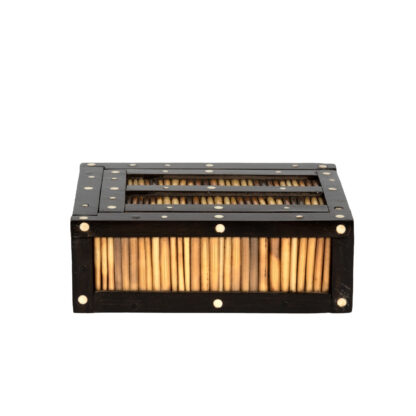This page was exported from Garden Court Antiques
[
https://www.gardencourtantiques.com
]
Export date: Wed Dec 17 16:44:09 2025 / +0000 GMT

Anglo Indian Ebony and porcupine quill box with sliding top, Circa 1880. Box C

List: $750
Anglo Indian Ebony and porcupine quill box with sliding top; India made for an English market,[1. Although porcupine quill boxes were originally made for English residents, by the late 19th century, there was a thriving commercial export trade. The production of porcupine quill boxes and furniture falls between around 1850 and 1900. https://en.wikipedia.org/wiki/Sinhalese_porcupine_quill_boxes Sinhalese Porcupine Quill Boxes Wikipedia] [2. Made In India For The British Market: What is known about furniture made in India for British use is that European cabinetmakers were working in India as early as the mid-18th century. The market was spurred by the prohibitive costs of shipping furniture and the long wait for goods from England. In time, as the British population increased, European craftsmen trained native artisans to carve Western styles. Eventually, Indian craftsmen became more expressive and innovative, adding their own motifs.
The most noticeable difference between English-styled Indian-made furniture and the British originals, is the extravagant use of exotic woods, metals and ivory. Richly figured calamander, rosewood and satinwood add a strong sense of presence bordering on the theatrical to these neo-classical designs. The lavish use of the blackest ebony to frame furniture creates some startling effects.
Sometimes, the Indian boxes seem almost modern in their simplicity.
Antiques: Made In India For The British Market. The New York Times, October 27, 1985, Section 2, Page 33 https://nyti.ms/3OB9G4b ] circa 1880.
height: 2 in. 5 cm., width: 5.5 in. 14 cm., depth: 4 in. 10 cm.
- Item Number: JG-437-C
- Country: Ceylon, India
- Period: 19th Century
- Creation Date: Circa 1880
- Materials: Bone, Ebony, Porcupine quill, Quill
- Height: 2 in., 5 cm.
- Length: 14 cm., 5.5 in.
- Depth: 10 cm., 4 in.
- Condition: Very good
Product export as MS Document by WooCommerce PDF & Print plugin.